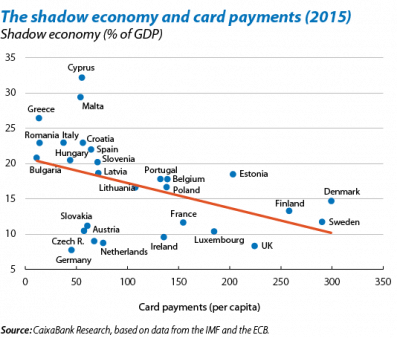Digital money in the economy of the future: new possibilities, new challenges
The bewildering technological advances that we are witnessing today open the door to a more widespread use of digital currencies in the not-too-distant future. But what is the potential of these currencies and how far can they go? In this article, the last stop of our journey on the history of money, we will travel into the future to reflect on these topics and their possible implications. It is a futuristic and exciting field, given that today we have more questions than certainties. But this should not discourage us, as the great French writer Victor Hugo said: «The future has many names. For the weak it is the unattainable. For the fearful, the unknown. For the brave, it is opportunity».
To begin with, it should be made clear that digital currencies already exist: the reserves held by retail banks in the central banks and the payments we make with credit cards are examples of digital money. Having said that, in this article we will go a little further, because we believe that the technological progress related to blockchain technology and the speed of electronic payment systems will allow digital money to play a much bigger role in the economy of the future.
Once the technology has been improved, we will be able to begin to think about how to implement a digital currency with much more widespread use. The first question is surrounding who should implement it. There are two alternatives: private digital currencies (examples such as Bitcoin already exist) or a digital currency that has the guarantee of the central bank (which we will call CBDC, as an acronym of central bank digital currency). Private digital currencies may seem like an attractive option, but as we have seen in the article «What can we expect from cryptocurrencies?» in this same Dossier, they suffer from certain limitations which make it difficult for their use to become successfully widespread. In contrast, the institutional mechanisms which the central banks enjoy in the financial system can help their implementation to be more fruitful. Thanks to their reputation and credibility,1 central banks have the capacity to ensure that the CBDC becomes legal tender and to generate a climate of trust so that it is perceived as a reliable and safe asset. In addition, a central bank has many more resources, more information and technical capacities in order to implement an appropriate monetary policy at any given time and to preserve the digital currency’s stability as a unit of account, thus avoiding sudden fluctuations in its price. This contrasts with the pitfalls that a private digital currency would face; at the end of the day, it is difficult for a private entity that is responsible for implementing a digital currency to have the relevant tools to design a credible standard of monetary supply with socially desirable objectives, such as stability in the price and in economic activity. This leads us to an initial conclusion on this intrepid «journey into the future» we have embarked upon: a digital currency backed by the central bank will stand more chance of being successfully implemented and used than a private digital currency. For this reason, in the rest of this article we will focus on analysing how the CBDC could be implemented, before delving into its advantages and disadvantages. In all scenarios, we will assume that the CBDC coexists with cash.
Broadly speaking, there are two natural ways to implement a CBDC, one of which is more limited (option 1) and the other of which is more disruptive (option 2). The first option would involve converting the euros we hold in our bank account into CBDC when making a payment or transfer, so that the transaction can be settled using the technology designed to implement the digital currency. Clearly, this first option would not affect individuals or companies when planning their domestic economies: simply, their euros would be converted into CBDC whenever they made a payment or transfer, and the underlying technology would allow the money to flow from sender to receiver without them noting any obvious change. It is worth emphasising that the creation of the CBDC would not introduce any substantial improvements in comparison to recent developments in payment systems. Two prime examples of these advances are the Single Euro Payments Area (SEPA), which sets a maximum period of one business day for the execution and settlement of euro-denominated transfers between 34 European countries, and the set of services which allow for instantaneous financial transactions to be carried out using mobile phones. Significant progress has been made in both cases, without the need for a digital currency backed by the central bank. One advantage of the CBDC in this scenario could be, perhaps, the increase in the speed of transfers between payment systems that are not interconnected, such as in the case of international transfers. This is an area in which Bitcoin and other digital currencies have already demonstrated certain advantages.
The second option would go further than the mere creation of the CBDC for making payments. In option 2, the central bank would sponsor a digital currency without restrictions, which would become another asset available to individuals and households and, therefore, would compete with bank deposits and cash. This second avenue could be approached in different ways. The two most logical alternatives would be to allow individuals and companies to deposit a portion of their savings in the form of CBDC, either in digital wallets2 or directly in accounts held in the central bank.
This scenario would represent a novelty in people’s daily lives: households and companies could choose to place part of their savings directly in their digital wallets or in the central bank (it should be remembered that today, only a limited group of financial institutions can deposit money in the central bank). Interestingly, there is a historical precedent that is very similar to the second alternative for bringing about option 2, albeit without the digital medium of modern times, of course: up until the early 20th century, individuals and companies were allowed to deposit their money in both the Bank of England and the Bank of Sweden. However, this practice later ended, since in the age of paper it was highly impractical and occupied a lot of space to record all the details of the large number of accounts that had been opened.
From now on, we will focus on analysing the implications of option 2, since, unlike the first option, it would have significant repercussions. Let us begin by discussing its advantages. We have identified three potential benefits associated with the implementation of the CBDC. The first one would be a potential reduction in the size of the shadow economy. This is critically dependent on the degree of anonymity of the CBDC. The most reasonable solution would be for the CBDC to be anonymous in small transactions but for there to be a certain level of control starting from a particular amount. If this were the case, a CBDC that became popular thanks to its speed and ease of use might discourage the use of cash and reduce the size of the shadow economy. Various studies support this theory3 and have documented that an increase in the use of electronic payment systems decreases the size of the shadow economy. This negative relationship in the euro area can be seen in the first chart, and the figures are revealing: an increase of 100 euros per capita per year in card payments would reduce the shadow economy as a percentage of GDP by as much as 3.5 pps.
The second advantage would be households’ and companies’ access to a risk-free asset (by definition, the central bank cannot go bankrupt) which, unlike cash, would involve no storage costs.
Finally, a third advantage would be that the central bank could improve the effectiveness of monetary policy. Specifically, if the CBDC were to allow households and companies to open accounts directly in the central bank, the central bank could directly adjust the interest rates on the assets of households and companies. This could prove to be a useful tool in financial crises if the mechanism for transmitting monetary policy does not work well. In fact, setting an interest rate on the CBDC would also affect the deposits of retail banks, since they would have to offer a sufficiently attractive remuneration in order to prevent their customers from transferring their deposits to the central bank. In any case, the debate surrounding the benefits of such a tool should revolve around the extent to which it would improve the effectiveness of monetary policy in comparison to the instruments currently available to the central bank. It is worth remembering that in recent years, the central banks have had a much more direct influence on the costs of financing for individuals and companies, through the purchases of public debt securities (see second chart) and corporate debt that they have carried out through their various quantitative easing (QE) programmes.4
Despite the advantages we have discussed regarding this implementation of the CBDC, we would be foolish to fall into complacency, since there are also risks that are by no means insignificant. The main risk of creating a widely-used CBDC would be the risk of the central bank having an excessively important role in the distribution of resources in the economy, as well as the risk of a potential rise in the cost of credit, depending on the central bank’s actions. To understand why, it must be borne in mind that with this implementation of the CBDC, a portion of the banking deposits of households and companies held in retail banks would be converted into CBDC (either held in digital wallets or in the accounts of the central bank). Therefore, in order for the retail banks to continue to finance the demand for credit, the most natural avenue would be for them to obtain the necessary liquidity from the central bank. If the central bank decided to take on this more interventionist role as a supplier of liquidity, the retail banks would be highly dependent on the liquidity that the central bank would provide.
If the central bank is able to adapt quickly and the distribution of liquidity is carried out applying the appropriate criteria, the problem would be resolved. However, if this is not the case, it could result in a rise in the cost of credit. In fact, the increased role of the central bank in distributing resources in the economy could lead to distortions in their allocation (a decentralised mechanism in the hands of the private sector will always lead to a more efficient allocation) and could complicate the setting of prices based on market criteria. This last point is only novel to a certain extent, since we can draw a parallel with the greater role that central banks have taken through their ultra-expansive QE policies in the last decade. In this regard, the Bank for International Settlements has repeatedly expressed fears that interest rates kept at abnormally low levels for such a long time are generating distortions in the valuation of some financial assets and are contributing to prolonging the upward spiral in the levels of debt of the major economies.
If the central bank were to waive this interventionist role and adopt a hands-off stance to liquidity problems, on the other hand, retail banks would have to obtain the resources necessary to finance the demand for credit themselves (possibly by increasing rates on deposits, to prevent customers from transferring their money to the central bank), and this would also end up producing a rise in the cost of credit.
Finally, it is worth adding that the potential dependence of the economy on the central bank could be particularly pronounced in times of recession, since it is precisely during periods of economic crisis that individuals and companies tend to be more risk averse. As a result, they would surely convert more of their assets from retail bank deposits into CBDC, which could lead to episodes of financial instability. These risks must not fall on deaf ears. In fact, they have been highlighted by the Bank for International Settlements and by the member of the ECB Yves Mersch5 when displaying their reticence with regard to the desirability of this option.
In short, we end our intense journey with the conviction that the possibility of the central banks deciding to issue their own digital currency to a wide audience in the future is no pipe dream. This possibility is a prime example of how technological development is making us rethink the current system. In the next few years, the main central banks and financial bodies will spell out the advantages and disadvantages of these currencies and it will be important to closely follow the developments that arise in this field. This article contributes to the discussion by identifying possible repercussions of issuing a currency of this kind. Debate around the matter is, and will be, more than welcome, provided that the costs are thoroughly analysed and the possible implications are well understood.
Javier García-Arenas and Marta Guasch
CaixaBank Research
1. For further details on the central banks, see the article «From barter to cryptocurrency: a brief history of exchange» in this Dossier.
2. These wallets h could be disconnected from retail banks. They would be very similar to the wallets of today, where we keep banknotes and cash, but in a digital format.
3. For further details, see the article «The shadow economy: too great a burden» in the Dossier of the MR09/13.
4. According to data from the IMF, 9 out of the 15 billion dollars of assets acquired by the central banks that have embarked on QE programmes in the last decade are sovereign debt securities.
5. See the report «Central bank digital currencies» (2018), by the Committee on Payments and Market Infrastructures of the BIS and Y. Mersch (2017), «Digital Base Money: an assessment from the ECB’s perspective», speech at the Bank of Finland.





